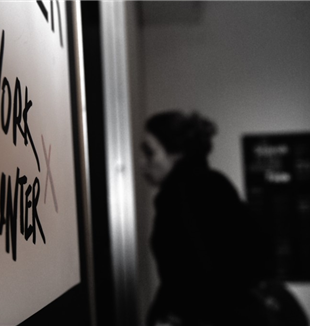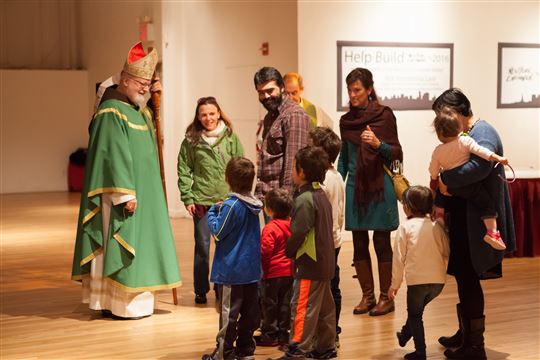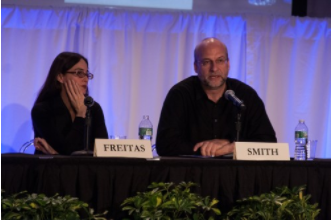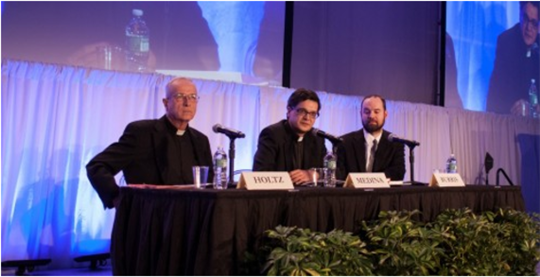
NYE 2015: Sunday, Day 3
Cardinal Sean O'Malley, the impact of Msgr. Giussani's life on different lives, social media and the human face, and more on the third day of the New York Encounter.Searching for a Human Face
The cold and rain would have been daunting for a day in New York, if not for the enthusiasm we already felt for what was happening inside of the Metropolitan Center. In fact, the miserable weather seemed easy to shoulder precisely because we could barely wait to start the third and last day of the New York Encounter.
Cardinal Sean O’Malley, the Archbishop of Boston, accompanied us at mass on Sunday morning. In his homily, Cardinal O’Malley cut straight to the fact that we are assembled here together because of a concrete encounter—like that of John, Andrew and Peter in the Gospel—with a fact in the flesh. In this meeting, the Cardinal reminded us, we are transformed: “Discovering the love of Jesus, for us, is the beginning of an adventure; we begin to understand who we are and why we are here.”
The Cardinal focused heavily on the figure of the human fragility of Peter, whose vulnerabilities were constantly on display in the gospels. Peter was a man, he noted, who was extremely limited: impetuous, cowardly, and frankly, the Cardinal joked, a bad fisherman and poor for that reason. “He only ever caught something when Jesus would specifically point out where to lower his nets,” the Cardinal exclaimed. However, the Cardinal helped us to see that Jesus does not choose those who are “qualified”; he chooses the limited, and from them requires only the response of faith, hope and charity to his provocative friendship. He ended by inviting all of us to become “wounded healers” like Peter.
Fr. Giussani’s Legacy: Witnesses
The next event was a panel of witnesses who spoke about the impact of Fr. Giussani’s life upon their own. Archibald Spencer, professor at Northwest Baptist Theological Seminary in Canada, recounted that his first encounter with Don Giussani was in 1998, when a book was thrown on his desk for adjunct review. The book was Giussani’s The Religious Sense. The theologian was blown away by the Catholic priest’s serious treatment of religion, which surprised Spencer, who was brought up to believe that Catholics were “the sinners and candidates for evangelization.”
Spencer’s review eventually put him in contact with the Movement, and he was invited to speak at the Meeting in Rimini, an experience, he said, that was “indelible.” During this visit, Spencer was invited to have lunch with Msgr. Giussani. As they met, Spencer introduced himself by saying, “I hope you will receive me, a poor Protestant sinner.” Don Giussani responded, “Only if you will receive me, a poor Catholic priest and a worse sinner than you.” Professor Spencer recalled that the dinner with Fr. Giussani made him “laugh, cry, sigh, and long for God.” It was a meeting that he has never forgotten. In the end, the theologian told us that, for him, the encounter with Don Giussani, transformed his understanding of friendship, grace, and humanity leaving him with anticipation for an even greater encounter one day.
The next speaker, Dr. Kim Shankman, academic dean of Benedictine College, started her talk on a surprising note. She had two confessions: “I’ve never met Fr. Giussani,” she said, “And I’ve never understood a word that he has written.” She explained that reading Giussani is, for her, like watching cricket: as soon as she finds a pattern in the apparent chaos, something entirely unexpected happens and she becomes lost again. Nevertheless, as Communion and Liberation began to grow at Benedictine College, she was attracted to the people of the Movement. However, she said that although she was attracted, she never thought that the beautiful way in which these people lived could ever become her own. In particular, she recalled a college student speaking about his sister suffering from cancer who said of his sister, “I know she doesn’t belong to me. She belongs to Another who loves her.” She remembered thinking that she could never be that strong.
However, a few months later, her son John suffered a severe traumatic brain injury. In the moments immediately following his accident, Dean Shankman began to realize how much her life had been changed by meeting the Movement. In front of her traumatically injured son, she found that she could say the same thing about John that the college student had said about his sister: “I know he doesn’t belong to me. He belongs to Another who loves him.” Dean Shankman closed by saying that she still does not understand the “key terms” of the Movement but she does have the unshakeable experience of joy and positivity even amidst the drama of life.
The last to speak was Elizabeth Peralta, a senior at Saint Francis College. She described her sadness and numbness going through high school, an experience that continued until she found herself at a School of Community. At this meeting, she posed a question: “If God exists, then why did my father leave?” The response she received shocked her. A woman present at the meeting said to her, “I cannot give you an answer. But I can suffer with you.” Never before had Liz experienced a gesture of friendship willing to share also in her suffering, rather than just the easy parts of life.
As she began to spend more time with these friends, Liz saw her life transforming. As her father kept scheduling meetings with her and then letting her down, she became more and more angry. To her surprise though, throughout all of the disappointment caused by her father, she found the woman who promised to suffer with her always at her side. This friendship lead her to the Church and to receive the sacraments, not because it is formally required by the Church, but because it was explained to her as “the ultimate dialogue with Christ,” a dialogue that had already begun to transform the details of Elizabeth’s life. This transformation for Liz was not one devoid of pain, however. Liz told us that meeting the Movement “made reality more thick” and lifted her fear of having an aching heart. In the end, Elizabeth identified the source of the beauty of her life very simply: “here I can belong to Christ.”
Face Formed by Social Media
In the first afternoon session, author and social media researcher Donna Freitas and Christian Smith, professor of Sociology at Notre Dame, helped guide us through the question: how is the digital revolution transforming our sense of self? Online existence is poignantly marked by paradox. Freitas noted that the students she has interviewed expressed both a sense that their online selves were not who they really were, but that nonetheless it was a space where they are always being watched and where they needed to appear to be happy at all costs. On the other hand, more ephemeral or anonymous social outlets like Snapchat allowed them a “playground” space where they could be silly, sad, scared, or angry––in short, themselves.
Smith noted that many young people feel simultaneously attracted to and alienated by their cell phone. He recounted many stories of those who were unable to access their cell phone service—during a year abroad, for example—and who, after a period of withdrawal, came to feel as if a fog was lifted from their eyes. Life was more enjoyable, conversations more substantial, and surrounding realities became more interesting. Freitas confirmed that many people feel that they cannot escape being online, yet they express a desire to ritualize, that is, make space for unplugging. It is this fact, the desire for authentic connectivity, and its necessary correlate, the ability to spend time silently with oneself that should serve as the starting point for a dialogue about the role of social media in our search for identity.
Education and Identity
What brings out the human face in education? This was the focal point of the second of Sunday afternoon’s presentations, this time on the current state of education. In a dialogue moderated by Fr. Jose Medina, president of the fraternity of Communion and Liberation in the United States, Fr. Albert Holtz OSB, a teacher at St. Benedicts Prep in Newark, NJ, and Darren Burris, Director of Instruction at Boston Collegiate Chartered Schools, discussed a topic that seems to be currently dominating much of the public sphere. Despite such a profound and controversial topic, the conversation was full of an unprecedented supply of jokes and humor. It was the great passion and vivacity with which these three educators live out their vocation that generated such a relaxed and enjoyable tone.
Holtz, a Benedictine monk for over 40 years, joked, “The students run the school.” The students are given a great deal of leadership and decision making positions. By telling a student that he is capable and in giving him the freedom to carry out tasks on his own, you provide him with an affirmation of the value of his humanity that he may not have realized if someone had not had such faith in his capability. “Why pay someone to do a job that a 17 year old could do?”
Far from being a removed, sentimental gesture, the way in which they spoke hinted at a possible alternative in which this larger discussion of the state of education might benefit from turning toward: an interest in the exceptionality of the circumstances and the totality of the humanity of each student, much like the context of a family that bears the faults and triumphs of each of its members together.
Infallible Criterion
Sunday culminated in a conversation with Fr. Julian Carron, international president of the Fraternity of Communion and Liberation. Fr. Carron offered a powerful provocation regarding the theme of the encounter. We could highlight his contribution in three words:
First word: BUT
“We all desire to live for something great, but . . .” Father Julian Carron began his talk by nothing that we all deep down want to live for something great, for our lives to be outrageously meaningful, joyful, peaceful. Yet he pointed out that what most characterizes our “modern” problem is the belief that a journey to the bold target of our heart’s desire for fullness is not possible. As Kafka comments, “There is a destination; but there is no road.” As a result of our “but”, our skepticism and excuses, we settle, and the heart becomes encrusted from a lack of use.
Fr. Carron laid down a challenge for all of us: who among us is open to recognize, to put in to play the fact we cannot on our own get to what we are looking for? And who is simple enough to accept that it the most important question worth facing?
Second word: CERTAINTY
Fr. Carron connected this search for the consistency of the self with certainty, both about who I am and thus where I am going and how I can journey there. He proposed that this is not a matter of ethics or coherence, but a problem of truth or knowledge: what is the truth of my “I” and what or who can respond adequately to its need?
Third word: HEART
We have everything we need to discover this certainty. It is our heart, as Carron says, citing Fr. Giussani, that contains the criteria and evidences we need to reach this certainty. As children of modernity, we may object that this turn to “subjectivity” is too precarious, too risky. But Carron challenges us on this presumption: I reach this certainty about who I am and where I am going by comparing my experience to my heart, the core of who I am. How else could I know? The dynamic is no different than using my foot as the criterion for the shoes I buy––they have to fit. We think the heart is merely subjective, because it has become encrusted by a lack of use.
This method (path) is no different than that of the apostles in their encounter with Jesus. They followed someone whose gaze revealed the origin and destiny that they had groped for before meeting him. Their experience of certainty—that is, of peace, joy, and fullness—shows that the heart, in the way that Giussani speaks about it, is the only starting point for living life as a relationship and not as some sickness we need therapy for, or problem we need to solve. Only if life is relationship do we have the possibility of continually discovering the surprise of our full humanity, as the apostles did.